The past year was a good one for Abu Dhabi, both in terms of economic performance and its progress towards a more diversified economy – the principle goal of the Abu Dhabi Economic Vision 2030, formulated some five years ago. On the macroeconomic level, the emirate’s GDP growth is expected to come in at around 4.5% for the year, with ratings agencies such as Standard & Poor’s granting it a stable outlook thanks to its strong fiscal and external positions.
Non-oil growth
While robust oil prices have helped to propel the economic growth of the hydrocarbons-rich emirate, a number of other sectors put in strong performances over the year. The real estate sector, aided in part by the UAE’s status as a safe haven in a politically troubled region, posted a particularly strong showing, with the average residential sales price increasing by 5% in the second quarter, according to property advisory firm Jones Lang LaSalle. This trend was further reinforced by the September implementation of a new rule requiring government employees – many of whom had secured cheaper rents in neighbouring Dubai – to relocate to the capital.
The transport sector represented a further buoyant area of the economy. Abu Dhabi International Airport served 12.2m passengers during the first nine months of 2013, a year-on-year (y-o-y) rise of 12.1%, according to the Abu Dhabi Airports Company.
Efforts to boost the emirate’s manufacturing output, an important part of its diversification strategy, continued apace. The recently established Khalifa Industrial Zone Abu Dhabi (Kizad) is the seed bed for much of this activity, and the industrial clusters envisaged there will, by the zone’s scheduled completion date of 2030, include a container and industrial port with more than 100 sq km of free and special economic zone space.
An aluminium cluster has already begun to form at the site, where anchor tenant Emirates Aluminium (EMAL) has been recently joined by the Taweelah Aluminium Extrusion Company, which is establishing itself nearby to manufacture extrusion products primarily for the automobile market The emirate’s aluminium industry underwent a seismic change in June 2013, when Abu Dhabi’s government-owned investment company, Mubadala Development Company, a 50% stakeholder in EMAL, bought a share of Dubai Aluminium Company. The $15bn joint venture resulting from the merger, named Emirates Global Aluminium, became the fifth-largest aluminium company in the world.
Financial drivers
The past year also saw some important developments regarding the emirate’s financial sector. One of the biggest financial stories was the announcement in June that Morgan Stanley Capital International (MSCI) will include the emirate’s bourse, the ADX, on its influential Emerging Markets index in 2014. The shift from Frontier to Emerging Market status represents an important vote of confidence in the ADX and has the potential to bring increased inflows of liquidity from the thousands of international fund managers that track the MSCI index. Moreover, this liquidity may provide more incentive for initial public offerings, the occurrence of which has slowed since 2008, as well as cross-listings from regional firms keen to gain emerging market exposure.
The development comes at an auspicious time in the context of potential changes to the geography of Abu Dhabi’s financial sector: The emirate has been developing a number of free zones since 2007, covering areas such manufacturing, media and light industry, but in 2013 the government released details concerning a new initiative which promises to significantly expand the concept in the emirate: Al Maryah Island, already the site of a new mixed-use financial, retail, residential, leisure and commercial development, is to be established as a financial free zone with its own regulatory system, legal structure and inventory of incentives. Its establishment will represent a significant step in the development of the economy, and has the potential to spur new growth in the already vibrant financial sector.
Looking ahead to 2014, GDP growth is expected to remain strong, with estimates converging around the 4% mark. For the financial sector, the period will likely see the resolution of the question of lending limits to government-related entities, which may have a significant impact on the loan books of the emirate’s banks. The non-oil sector, meanwhile, is likely to continue to grow on the back of increasing private sector consumption and a series of large construction projects, such as the ongoing expansion of Abu Dhabi International Airport and the development of the 1500-km Etihad Railway, along with its future links to other GCC countries.
Follow Oxford Business Group on Facebook, Google+ and Twitter for all the latest Economic News Updates. Or register to receive updates via email.

